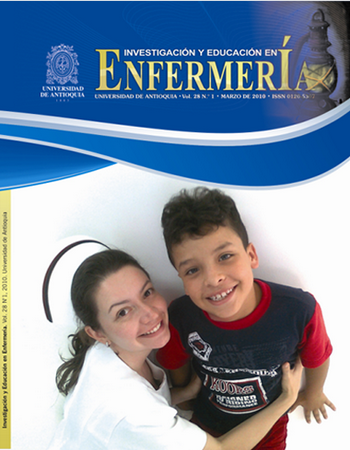Cardiovascular risk, quality of life and quality-adjusted years of life: a case report
DOI:
https://doi.org/10.17533/udea.iee.5478Keywords:
Cardiovascular diseases; risk groups; program evaluation; quality of life.Abstract
Objective: to determine the ratio cost-utility of cardiovascular diseases (CVD) promotion and prevention programs in a health care providing institution in the city of Medellin (Colombia).
Methodology: the preventive program was compared before and after with the conventional control scheme under the design of a quasi experimental study evaluation with a non equivalent control group. Between the studied groups' differences of the following results were evaluated at the end of the first and second year: Framingham score, direct cost of the program, quality of life, health indexes and quality-adjusted years of life.
Results: in the evaluated groups a statistically meaningful difference was found between the initial and final moments for the variables: Framingham score, direct cost of the program, quality of life, health indexes and quality-adjusted years of life.
Conclusion: the participation of patients in CVD prevention and promotion programs is related with risk reduction and a better quality of life.
Downloads
References
(1) Organización Mundial de la Salud. Primer informe de la comisión macroeconómico y salud: enfermedades cardiovasculares. Ginebra: OMS; 2003.
(2) 2.Silva FA, Zarruk JG, Quintero C, Arenas W, Rueda CF, Silva SY, et al. Cerebrovascular disease in Colom- bia. Rev Col Cardiol. 2006;13(2):85-89.
(3) World Health Organization. Cardiovascular diseases. Fact sheet No. 317 [Internet]. Geneva: World Health Organization; 2009 [acceso 23 de octubre de 2009]. Disponible en: http://www.who.int/mediacentre/factsheets/fs317/en/print.html
(4) Margareta EK, Westerborg CJ, Eliasson MC. A randomized trial of lifestyle intervention in primary healthcare for the modification of cardiovascular risk factors. J Public Health. 2006;34(5):453-61.
(5) Greenland S. Epidemiologic measures and policy formulation: lesson from potential outcomes. Emerging Themes in Epidemiology [internet]. 2005 [Acceso 2008 Sep 10];2. Disponible en: http://www.eteonline.com/content/2/1/5
(6) Wilson PW, D‘Agostino RB, Levy D, Belanger AM, Silbershatz H, Kannel WB. Prediction of coronary heart disease using risk factor categories. Circulation. 1998;97(18):1837-47.
(7) Grundy SM. Primary prevention of coronary heart disease: integrating risk assessment with intervention. Circulation 1999 Aug 31;100(9):988-98.
(8) Grundy SM, Pasternak R, Smith S, Fuster V. Evaluación del riesgo cardiovascular con la utilización de las ecuaciones de evaluación de factores de riesgo múltiples. J Am Coll Cardiol. 1999;34:1348-1359.
(9) Pearson TA, Blair SN, Daniels SR, Eckel RH, Fair JM, Fortmann SP. AHA Guidelines for primary prevention of cardiovascular disease and stroke 2002 update: consensus panel guide to comprehensive risk reduction for adult patients without coronary or other atherosclerotic vascular diseases. Circulation. 2002;106:388-391.
(10) Aktas MK, Ozduran V, Pothier CE, Lang R, Lauer MS. Global risk scores and exercise testing for predicting all-cause mortality in a preventive medicine program. JAMA 2004;292(12):1462-68.
(11) Krabbe P, Weijnen T. Guidelines for analysis and reporting EQ-5D outcome. En: Brooks R, Rabin R, Charro F. The measurement and valuation of health status using EQ-5D: a European perspective. London: Kluwer Academic Publisher; 2003. p.7-19..
(12) Brazier J, Deverill M, Green C, Harper R, Booth A. A review of the use of health status measures in economic evaluation. Health Technol Assess. 1999;3(9).
(13) Grieve R, Grishchenko M, Cairns J. SF-6D versus EQ- 5D: reasons for differences in utility scores and impact on reported cost-utility. Eur J Health Econ. 2008;2(8).
(14) Centre for health Economics. Time trade- off user manual: props and self- completion methods. New York: Gudex; 1994.
(15) Tsuchiya A, Ikeda S, Ikegami N, Nishimura S, Sakai I, Fukuda T, et al. Estimating an EQ-5D population value set: the case of Japan. J Health Econ. 2002;11(4):341 – 353.
(16) Gibbon C, Morris L. How to desing a program evaluation. 2a ed. London: Sage Publication; 2002.p. 86-96.
(17) Dolan P, Stalmeier P. The validity of time trade-off values in calculating QALY´s: constant proportional time trade-off versus the proportional heuristic. J Health Econ. 2003;22(3):445–458.
(18) Dolan P. Modeling Valuations for EuroQol Health States. Med Care. 1997;35(11):1095-1108.
(19) Drummond MF, Sculpher MJ, Torrance GW, O’Brien BJ, Stoddart Drummond GL. Analisis coste-utilidad. En: Methods for the economic evaluation of health care programmes. 3a ed. Oxford: University Press; 2005. p. 157-231.
(20) Flanders DW. On the relationship of sufficient component cause models with potential outcome (counterfactual) models. Eur J Epidemiol. 2006;21:847-853.
(21) Eriksson KM, Westborg CJ, Eliasson MC. A randomized trial of lifestyle intervention in primary healthcare for the modification of cardiovascular risk factors The Björknäs study. Scand J Public Health. 2006;34:453.
Downloads
Published
How to Cite
Issue
Section
License
Derechos de propiedad / Direitos de Propriedade
English: If the article is accepted for publication, all copyright will be of exclusive property of Investigación y Educación en Enfermería. The text and the graphics included in the publication are exclusive responsibility of the authors and not necessarily reflect the thought of the Editorial Committee.
Español: Si el artículo es aprobado para publicación, todos los derechos son de propiedad de Investigación y Educación en Enfermería. El texto y las gráficas incluidas en la publicación son de exclusiva responsabilidad de los autores y no necesariamente refleja el pensamiento del Comité Editorial.
Português: Se o artigo for aceito para publicação, todos os direitos autorais serão de propriedade exclusiva de Investigación y Educación en Enfermería. O texto e os gráficos incluídos na publicação são de responsabilidade exclusiva dos autores e não refletem necessariamente o pensamento do Comitê Editorial.















